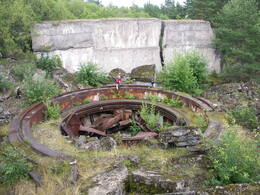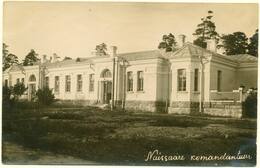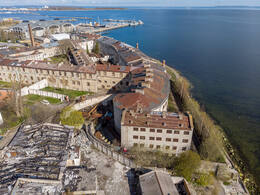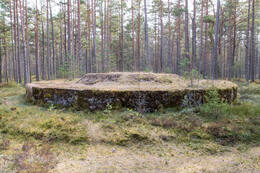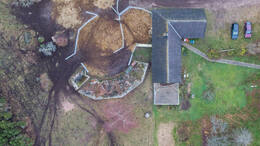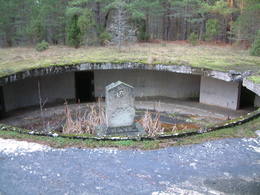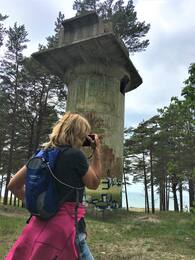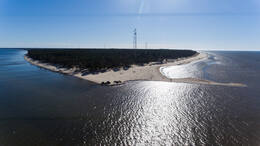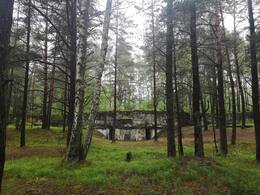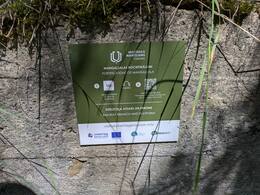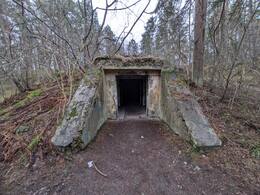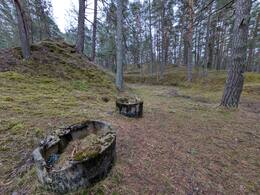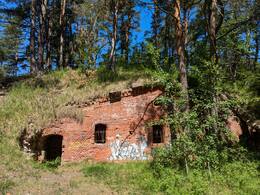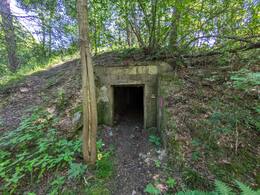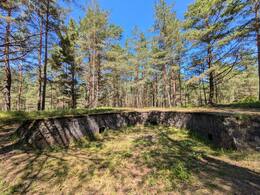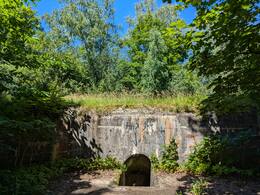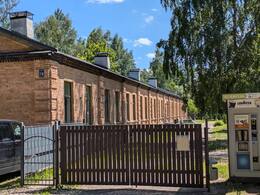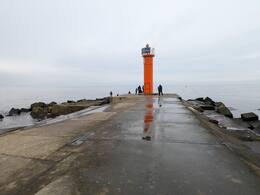Pakrančių gynyba
I WW1, II Antrasis pasaulinis karas
Pakrančių gynyba – tai karinių priemonių visuma, skirta teritoriniams vandenims ir laivų keliams prie kranto, pakrantei ir karinės svarbos uostams bei įrenginiams prie kranto ginti nuo karinių jūrų pajėgų pasalų ir kitų karo veiksmų. Pakrančių gynybą vykdo atitinkamos kariuomenės ir karinio jūrų laivyno rūšys.
Pakrantės gynybos svarba išaugo plačiai paplitus šaunamiesiems ginklams – pakrantės gynyba buvo pavesta baterijos bokštui Storajai Margaretai. Švedijos laikais Taline buvo planuojama įrengti modernią pakrantės gynybos ir bastionų sistemą. Tobulėjant ginkluotei, bastionų sistema paseno, o po Krymo karo (1853–1856 m.) Talinas nebebuvo Rusijos imperijos įtvirtintas miestas.
Susijusios vietos
Aegnos sala
Trijų kvadratinių kilometrų ploto šioje saloje, esančioje šiaurės rytiniame Talino įlankos kampe, yra platus pakrantės gynybos baterijų tinklas ir trijų kilometrų siaurojo geležinkelio linija, nutiesta prieš Pirmąjį pasaulinį karą, tęsiant Petro Didžiojo XVIII amžiuje pradėtus įtvirtinimo darbus. Aleksandro Nevskio baterijos statyba pradėta 1915 m. 180 metrų ilgio betoninė konstrukcija abiejuose galuose buvo sujungta su barbetėmis, ant kurių buvo pastatytos po dvi 12 colių patrankas. Rytiniame gale esančios patrankos buvo aukštesnės nei vakariniame, todėl jas buvo galima šaudyti į vakarus virš kitų patrankų. 3-ioji baterija buvo pastatyta vakariniame Aegnos krante ir buvo paruošta kovai iki 1916 m. rudens. Iš pradžių buvo planuota, kad baterijoje bus šešios 130 mm patrankos, tačiau galiausiai jų buvo tik keturios.
1918 m., paskelbus Estijos nepriklausomybę, pakrantės gynybą perėmė Estijos karinis jūrų laivynas. Saloje buvo gyvenamieji namai, kareivinės, karininkų valgykla, štabo būstinė, duonos fabrikas, biblioteka, klinika, pirtis ir kt. 1927 m. saloje, Eerikneeme, buvo baigtas statyti vadovavimo centras. Tais pačiais metais buvo baigta statyti ir 10-oji baterija, aprūpinta trimis 75 mm priešlėktuvinėmis patrankomis (kurių vamzdžio ilgis – 3,75 m), galinčiomis šaudyti iki 6 km aukščio. Aegnos svarbą Estijos pakrantės gynyboje atspindi tai, kad salos klestėjimo metu pusė Karinio jūrų laivyno divizijoje tarnavusių vyrų buvo dislokuoti saloje. Esama infrastruktūra leido vietos gyventojams žiemą tvarkytis patiems, nes jūrų laivybos sutrikimai buvo dažni.
Po Antrojo pasaulinio karo Sovietų Sąjungos karinio jūrų laivyno Baltijos laivyno oro gynybos padalinys, kurį sudarė apie 100 jūrų pėstininkų, buvo dislokuotas Aegnoje iki 1957 m. Šalia Aleksandro Nevskio baterijos prožektorių bunkerio šiaurės vakarinėje salos dalyje buvo pastatyta nauja priešlėktuvinė baterija, sudaryta iš keturių betoninių pabūklų apkasų, išdėstytų 45 metrų atstumu viena nuo kitos. Buvo sumontuoti 40 mm „Bofors“ pabūklai, kuriuos anksčiau naudojo Estijos kariuomenė. Kadangi sovietmečiu Estijos pakrantė buvo draudžiama, kelionė į Aegną vėl tapo įmanoma tik septintajame dešimtmetyje. Saloje vis dar aiškiai matomi skirtingų karinių laikotarpių pėdsakai.
Naisaro sala
Šią 19 kvadratinių kilometrų ploto salą Talino įlankoje 1912 m. įsigijo Rusijos imperatoriškasis karinis jūrų laivynas, išstumdamas vietinius gyventojus. Karinis jūrų laivynas saloje pastatė uostus, geležinkelius ir pakrantės baterijas kaip Petro Didžiojo jūrų tvirtovės dalį. Pirmojo pasaulinio karo ir Nepriklausomybės karo metu saloje taip pat buvo karo belaisvių stovykla. Naujai nepriklausoma Estijos Respublika išlaikė salą kaip sukurtos pakrantės gynybos sistemos dalį, tačiau leido vietos gyventojams į ją grįžti. Sovietų okupacijos metu salą kontroliavo kariškiai, kurie joje pastatė jūrų minų depą ir gamyklą. Naisare sovietų armijos paliktus pastatus ir įrangą vis dar galima iš dalies apžiūrėti ir šiandien. Jūrų tvirtovei suformuotas bunkerių tinklas driekiasi giliai po žeme. Kai kurie bunkeriai ir artilerijos atramos vis dar prieinami. Visą salos apžvalgą galima atlikti per dieną. Saloje anksčiau buvo tankus geležinkelių tinklas, jungiantis karinius objektus. Štai kodėl likę takai yra puikus vadovas keliaujant po salą.
Naisare yra 40 kilometrų siaurojo geležinkelio, kurio tiesimas pradėtas 1913 m., caro laikais. Geležinkelio tinklas buvo iš dalies naudojamas ir nepriklausomybės laikais, ir sovietų okupacijos metu. Šiandien atkurta 2,4 kilometro ilgio jo atkarpa. Pakrantės žmonių muziejuje salos lankytojams eksponuojamos įvairios parodos, kuriose galima išsamiau susipažinti su salos istorija. Männiku kaime, sovietmečio karių gyvenamuosiuose namuose, eksponuojama karinė paroda, kurioje pristatoma tiek ankstesnė, tiek naujausia salos karinė praeitis. Naisare švyturyje veikia paroda „Naisaras ant senų atvirukų“, kurioje vaizduojama sala jos klestėjimo laikais.
Patarei jūros tvirtovė
Buvusi jūrų tvirtovė, esanti Talino Kalamajos rajone.
Karo inžinierių Étienne-Louis Boullée ir Claude-Nicolas Ledoux suprojektuotas Patarei tvirtovės statybas 1829 m. pradėjo vykdyti Rusijos imperatorius Nikolajus I. Kompleksas buvo atidarytas 1840 m., tačiau tai nereiškė, kad statybos darbai buvo baigti. Tvirtovė buvo renovuota: buvo baiminamasi, kad po Krymo karo pradžios 1853 m. britai ir prancūzai puls iš Baltijos jūros. Tai iš tiesų įvyko, tačiau į didelio masto karą tai neperaugo. Iš Patarei buvo paleisti tik keli šūviai. Pradėjus naudoti sprogstamuosius sviedinius, Patarei tvirtovė 1858 m. buvo uždaryta ir vėliau naudojama kaip kareivinės. Estijos nepriklausomybės laikais Patarei buvo paverstas kalėjimu, kuris veikė iki 2002 m. Jis taip pat buvo naudojamas kaip kalėjimas vokiečių ir sovietų okupacijų metu. Šių režimų čia įvykdyti žiaurumai šią vietą pavertė liūdnai pagarsėjusia tarp gyventojų. Architektūriškai iškiliame keturių hektarų pastate dabar įrengta paroda pavadinimu „Komunizmas yra kalėjimas“, kurioje dėmesys skiriamas komunistinei ideologijai, komunistiniams nusikaltimams ir pastato istorijai. Šio nuostabaus architektūros stebuklo, apimančio keturis hektarus, renovacija prasidėjo 2020 m. Iki 2026 m. „Patarei“ taps integruotu urbanistiniu kraštovaizdžiu su komercinėmis patalpomis, gyvenamosiomis patalpomis ir laisvalaikio praleidimo galimybėmis. Rytiniame pastato sparne bus išsaugotas originalus kalėjimo interjeras ir mankštos aikštelės. Jau dabar veikia beveik 1200 kvadratinių metrų ploto paroda apie komunistinę ideologiją, žiaurumus ir pastato istoriją.
12 colių pakrantės baterija Tahkunoje (Nr. 39)
Pagal įvairius Sankt Peterburgo jūrų gynybos sistemos planus, Estijos pakrantėje turėjo būti pastatyta iki penkiasdešimt pakrantės baterijų. Buvo suplanuotos trys 14 colių baterijos, bet nė viena nebuvo užbaigta. Buvo suplanuotos šešios 12 colių baterijos, bet užbaigtos tik keturios: Aegnoje, Naisare, Servėje ir Tahkunoje.
Kadangi pradiniuose planuose salose nebuvo numatyta jokių baterijų, karo meto statybos darbai buvo skubiai atliekami pagal supaprastintus brėžinius – nešarvuota artilerija buvo išdėstyta neuždengta ant apvalių betoninių platformų (15 m skersmens, 2 m aukščio, 4,5 m gylio). Tahkunoje buvo atlikta tik apie dešimtadalis betoninių darbų. Keturios pabūklai išdėstyti dviem poromis, atstumas tarp pabūklų – 64 m. 1917 m. birželį pabūklai buvo sumontuoti ant platformų ir atlikti bandomieji šaudymai. Rudenį buvo pranešta, kad baterija yra paruošta kovai, nors sumontuotas tolimatis buvo mažas ir neleido baterijai tiksliai šaudyti maksimaliu atstumu. Baterijoje tarnavo 220 kareivių.
12 colių patrankos vamzdžio ilgis buvo 15,8 m, svoris – 50 tonų. Sviedinio svoris – 450 kg, o sprogstamojo užtaiso – iki 156 kg. Didžiausias šaudymo nuotolis – 28 km. Vamzdžio eksploatavimo laikas – 300 šūvių, po to vamzdį reikėjo pakeisti. Tahkunos baterija buvo vienintelė 12 colių Estijos baterija, kurioje pabūklai išliko nepažeisti, nors, remiantis naikinimo komandos ataskaita, pabūklai buvo sunaikinti. Vamzdžiai buvo nugabenti į Naisaarą 1920-ųjų pradžioje baterijos renovacijai, tačiau šie darbai niekada nebuvo baigti. Vienas atsarginis vamzdis iš Naisaaro 1934 m. buvo parduotas Suomijai.
Šiandien Tahkunoje išlikusios visos keturios patrankų platformos, rodančios etapus, kai statybos darbai turėjo būti nutraukti. Trečioji pozicija yra labiausiai išbaigta. Patrankų platformos daugiau nei šimtmetį buvo veikiamos oro sąlygų, nepaisant to, betonas yra puikios būklės, o visi varžtų žiedai yra pilni. Tik betoną dengiantis samanų sluoksnis kasmet storėja, o aplinkinis miškas tankėja. Už patrankų platformų miške yra daugybė slėptuvių ir apkasų liekanų, pora betoninių pamatų, atpažįstama geležinkelio užtvanka ir drenažo grioviai. Maždaug 200 m į pietryčius nuo pirmosios patrankų platformos yra didelis susprogdinto šaudmenų rūsio krateris.
Hindu (Seru) 120 mm pakrantės apsaugos baterija Nr. 34
Baterijos statyba pradėta 1914 m. Kadangi tai buvo papildoma baterija, jos trūko pradiniame jūrų tvirtovės plane, o pabūklų tipas buvo ne kartą keičiamas. Galiausiai buvo sumontuoti keturi 120 mm „Vickers“ pabūklai. Pabūklų vietoms ginti buvo supilta 200 m ilgio ir 10–20 m pločio seklumos, kuri virš pabūklų buvo užbetonuota. „Hindu“ buvo vienintelė baterija Hijuma saloje, dalyvavusi koviniuose veiksmuose per Tagalahe išsilaipinimą 1917 m. spalio 12 d. Po trumpo susišaudymo su vokiečių karo laivais rusų artileristai pabėgo, palikdami bateriją nepažeistą. Vokiečiai pasiuntė į sausumą kareivių desanto būrį, kuris susprogdino baterijos pabūklus. Vienas iš vokiečių karo laivų, apšaudžiusių hinduistų bateriją, buvo „Bayern“ – didžiausio kada nors Estijos vandenyse buvusio karo laivo vandentalpa (ilgis 180 m, vandentalpa 32 200 tonų, aštuonios 380 mm pabūklai). Baterijos radijo stoties pastatas buvo perkeltas į Emmastę ir panaudotas kaip bendruomenės centras (nugriautas devintajame dešimtmetyje). Pabūklų vamzdžiai ir kitos didesnės detalės vis dar buvo ten 1937 m. Šiandien pirmoji ir antroji pabūklų platformos vis dar atpažįstamos, kitos dvi yra aptvertoje kieme. Trečiasis pabūklo krateris užpiltas žemėmis, o į jūrą atsiveria naujai pastatytas namas, ketvirtosios liekanos – tik suskilusi betoninė platforma. Iš dviejų oro gynybos pabūklų platformų išlikusi viena (šimtas metrų link slaugos namų, dešinėje kelio pusėje). Nepažeistų pastatų nėra. Kulkosvaidžių bunkeris tarp pirmosios ir antrosios pabūklų vietų buvo baigtas statyti 1941 m.
Kartu su hinduistų baterijos statyba buvo planuojama Lepiku kaime, kur buvo sukrauti dideli žvyro luitai, matomi iki šiol, pastatyti kažką. Koks tai turėjo būti pastatas, nežinoma.
317-oji 180 mm pakrantės gynybos baterija Ninasėje
Ši pakrantės gynybos baterija yra Ninasėje, netoli Saremos uosto, Tagaranos pusiasalyje. Prasidėjus Antrajam pasauliniam karui, Sovietų Sąjunga pradėjo tvirtinti Vakarų Estijos salyną, o Ninasės kaime, dirbamoje žemėje, buvo pastatyta pakrantės gynybos baterija, sudaryta iš keturių 180 mm pabūklų, siekiant atgrasyti priešą. Baterijos statybos darbai prasidėjo 1940 m. liepos mėn. Jos artilerija stovėjo 200–300 metrų atstumu viena nuo kitos, o netoliese buvo įrengtas generatorius, tiekiantis kompleksui elektros energiją. Baterija nebuvo naudojama kovos metu. 1941 m. rugsėjo 20 d. vokiečių kariuomenė apsupo bateriją. Baterijos įgulai pavyko susprogdinti du pabūklus ir pralaužti vokiečių liniją.
Ninasės pakrantės gynybos baterija yra vienas geriausiai išsilaikiusių Antrojo pasaulinio karo istorinių pastatų Saremos saloje ir tapo populiariu turistų traukos objektu. Pastaraisiais metais ji tapo dar patrauklesnė dėl netoliese vykstančio Mustjalos muzikos festivalio.
23-iosios Kranto baterijos pirmasis tolimatis (1941 m.)
Tolimačiai (datuojami 1941 m.) yra kopos pušyse, vos už 10 m nuo kito bokšto, pastatyto 1954 m. Kranto baterijos 1-oji ir 2-oji patrankų pozicijos yra pajūryje ir iš dalies eroduotos, o 4-oji patrankų pozicija geriausiai matoma kopose. Pabūklus aptarnavusių personalo gelžbetoninis bunkeris dabar nuplautas bangų ir turi išplautus pamatus, pasvirusius ir pasvirusius į jūrą.
Liepojos tvirtovės 2-oji baterija buvo planuojama statyti toliau nuo kranto linijos ir apsaugoti aukštu pylimu. Baterijos ginkluotė turėjo būti 16 11 colių (280 mm) minosvaidžių, pagamintų 1877 m. modelio. Minosvaidžiai turėjo taikyti stačias trajektorijas ir nereikalavo tiesioginio taikymo.
Pagal 1939 m. spalio 5 d. pasirašytą Latvijos Respublikos ir SSRS „bazių susitarimą“, Kuržemėje turėjo būti dislokuotas beveik 25 000 Raudonosios armijos ir Baltijos karinio jūrų laivyno karių kontingentas. Iki 1941 m. kovo mėn. Latvijoje, Irbės įlankos, Saremos ir Liepojos gynybos sektoriuose, buvo įkurtos Baltijos šalių karinio jūrų laivyno bazės, kurias sudarė pakrantės gynybos baterijos.
Liepojos pakrantės gynybos sektorių sudarė 208-oji artilerijos divizija su dviem 130 mm B-13 patrankų baterijomis (Nr. 23 ir Nr. 27) ir viena 180 mm bėginių patrankų baterija. 23-iosios baterijos statyba prasidėjo 1939 m. lapkritį ir buvo baigta 1941 m. gegužės 17 d., iš dalies panaudojant Liepojos tvirtovės 2-osios baterijos gelžbetoninius įtvirtinimus. 23-iąją bateriją sudarė keturios gelžbetoninės patrankų pozicijos pakrantėje, vadovavimo postas ir stebėjimo (atstumo matavimo) bokštas kopų miške. Atstumo matavimo pozicijos buvo išdėstytos gelžbetoniniuose bokštuose, siekiant užtikrinti geresnį matomumą ir kartu išlaikant paslėptą vietą pušyne.
Po Antrojo pasaulinio karo 23-ioji baterija buvo pervadinta į 636-ąją ir ginkluota tais pačiais 130 mm B-13 pabūklais, o 1954 m., greta 1941 m. bokšto, ugnies valdymui buvo pastatytas naujas šaudymo bokštas. 1963 m. buvo išardytos visos Liepojos pakrantės gynybos pabūklai.
Atkūrus Latvijos nepriklausomybę, 2-osios baterijos rajonas priklauso Gynybos ministerijai.
Vokietijos armijos pakrančių apsaugos prožektorių aikštelė Ūsyje ir pasienio apsaugos postas Kolkoje
Kolkos kyšulyje nebuvo planuojama jokios karinės infrastruktūros, išskyrus kelis jūrinius švyturius, kurie buvo atstatyti per ilgą laiką – prieš Pirmąjį pasaulinį karą, Pirmojo arba Antrojo pasaulinio karo metu. Siauriausioje Irbės sąsiaurio dalyje, tarp Sirvės pusiasalio ir Mykolo bokšto švyturio, buvo suplanuotos pakrantės gynybos baterijos.
Vieninteliai karinio pobūdžio įtvirtinimai atsirado 1944 m. pabaigoje, kai Vokietijos armijų grupė „Šiaurė“ ruošėsi atremti galimus sovietų Baltijos laivyno išsilaipinimus. 1945 m. pavasarį, ledui atsitraukus, dvi 532-osios artilerijos divizijos baterijos gynė pakrantę ties Kolkos kyšuliu. 7-oji baterija su keturiomis 75 mm patrankomis ir trimis 20 mm zenitinėmis patrankomis. 8-oji baterija su keturiomis 88 mm minosvaidžiais, trimis 20 mm minosvaidžiais ir 81 mm minosvaidžiu. Priešdezertyrinį pėstininkų garnizoną sudarė vienas garsiausių Vokietijos karinio jūrų laivyno pakrantės gynybos dalinių – 531-osios artilerijos divizijos 5-oji kuopa. Nors pavadinimu tai buvo artilerijos dalinys, pagal dislokaciją tai buvo pėstininkų dalinys, kuris savo karą pradėjo 1941 m. birželį prie Liepojos. Tuomet dalinys buvo dislokuotas Suomijos įlankos salose, o vėliau dalyvavo kovose Saremos saloje. Divizijos likučiai buvo pertvarkyti į vieną kuopą ir, sustiprinti septyniais prieštankiniais ir trimis 20 mm priešlėktuviniais pabūklais, dislokuoti Kolkos kyšulyje.
Sovietų jūrų desanto operacija niekada neįvyko, o vokiečių daliniai kapituliavo 1945 m. gegužę.
Karinė infrastruktūra Kolkos kyšulyje pradėta kurti po Antrojo pasaulinio karo, kai čia buvo dislokuoti sovietų pasienio apsaugos postai ir Kolka, kaip ir visa Kuržemės pakrantė nuo Mērsrago iki Lietuvos sienos, tapo uždara zona.
Mangalsalos įtvirtinimai
Pakrantės įtvirtinimai yra Rygoje, Mangaļsaloje, Dauguvos žiotyse, priešais Dauguvgryvą. Čia galima pamatyti skirtingų armijų (rusų, latvių, vokiečių ir sovietų) pastatytus įtvirtinimus. Mangaļsalos įtvirtinimai buvo pastatyti siekiant ginti Rygos miestą nuo priešo laivynų. Ši teritorija ilgą laiką buvo strategiškai svarbi. Po Pirmojo pasaulinio karo Latvijos armija dar neturėjo stipraus laivyno. Jūrų siena buvo ilga, o pakrančių gynyba darėsi vis sunkesne užduotimi. Latvijos armija perėmė Rusijos imperijos pastatytus įtvirtinimus XIX a. pabaigoje ir XX a. pradžioje ir išplėtė gynybos sistemą. Dauguvgryvos ir Mangaļsalos artilerija apšaudydavo priešo laivus, bandančius įplaukti į Dauguvos žiotis, o atramos punktai Lielupės (Jūrmalos) ir Gaujos (Carnikavos) žiotyse stabdydavo priešo desantinius būrius. Taip pat buvo specialiai įrengtas šarvuotas pakrantės gynybos traukinys, kuris galėjo teikti artilerijos ugnį ir paramą Saulkrastų arba Jūrmalos kryptimi. Strateginių vietų įtvirtinimo tikslas buvo maksimaliai padidinti ginklų panaudojimą, pasitelkiant specialias konstrukcijas ir reljefo pranašumus. Pakrantės gynybiniai įtvirtinimai buvo išdėstyti didelėje teritorijoje, kad karo atveju būtų galima atremti priešo pastangas.
Garso gidas https://izi.travel/en/edbf-mangalsala-fortifications/en
Geležinkelio atšaka ir platforma
Apie 1958 m. Mangalsaloje nuo Vecākių stoties buvo nutiesta speciali geležinkelio atšaka sovietų armijos reikmėms. Tai buvo patogiausias būdas į čia esančią karinę bazę atgabenti kuro, šaudmenų, šaunamųjų ginklų ir statybinių medžiagų. Dar anksčiau, nuo XX a. iki pat sovietmečio, per visą Mangalsalą ėjo siaurasis geležinkelis, kuriuo į patrankų vietas buvo gabenama šaudmenys. Vėliau buvo nutiesta rimtesnė geležinkelio atšaka, kirtusi Vecdaugavą per vieną iš dviejų – mažiausiai žinomų – Mangalsalos užtvankų. Pavyzdžiui, iš Vecākių pusės prieiti prie šios užtvankos nebėra įmanoma, nes vaizdą užstoja privati valda. Gamtoje matomas betoninis kalva buvo platforma. Kai dešimtojo dešimtmečio pradžioje sovietų kariuomenė paliko Latviją, šiuo geležinkeliu buvo gabenama 600 vagonų su maždaug 30 tonų šaudmenų. Sakoma, kad tuo metu tai buvo daroma taip skubotai ir nerūpestingai, kad „visa Ryga galėjo būti matoma ore“. Arba bent jau tam tikras Rygos rajonas. Netrukus po to geležinkelis buvo išardytas.
Uždari šaudmenų sandėliai, pastatyti šeštajame dešimtmetyje
Šeštajame dešimtmetyje toks bunkeris buvo pastatytas ir užpiltas žemėmis, kad potencialus priešas jo taip lengvai nerastų. Mangalsaloje iš viso yra keturi tokie pastatai, visi jie pastatyti 1953–1955 m. Sovietmečiu čia buvo laikoma amunicija – povandeninės minos, torpedos ir kt. Šiuo metu tai švariausias iš uždaro tipo sovietmečio amunicijos sandėlių, tačiau nuėjus toliau galima pamatyti ir didžiausią.
Dėmesio! Siekiant apsaugoti žiemojančius šikšnosparnius (visos rūšys yra saugomos), nuo spalio iki balandžio nesikelkite po žeme ir bunkeriuose.
Atviri šaudmenų sandėliai, žaibolaidžiai, šuliniai
Sovietmečiu į Mangalsalą buvo atgabenta tiek daug šaudmenų ir karinės įrangos, kad sandėliuose neužteko vietos, todėl didelę jos dalį teko laikyti po atviru dangumi. Patalpose buvo laikomi tik tie daiktai, kuriuos galėjo pažeisti drėgmė. Šis veiksmas taip pat rodo nerūpestingą sovietinės armijos požiūrį į bet kokį inventorių: aplink jį buvo įrengtas smėlio pylimas, iš kurio iki šiol išlikęs nedidelis kauburėlis, tačiau pats pylimas apsaugojo šaudmenis nuo gaisrų ir sprogimų. Jei šioje vietoje sprogtų raketa, sprogimo banga pasiektų pylimą ir nepasiektų toliau arba pasiektų daug mažesnį plotą. Netoliese yra gelžbetoninis stulpas – žaibolaidis! Tokie stulpai leido apsaugoti šaudmenis nuo žaibo smūgių. Panašių stulpų galima pamatyti ir kitose vietose. Matyti ir buvę vandens šuliniai, kad prireikus būtų galima ką nors užgesinti. Apskritai informacija apie Mangalsalos šaudmenų sandėlius buvo labai slapta – net senuose sovietiniuose kariniuose žemėlapiuose šios vietos pažymėtos kaip pionierių stovyklos. Maždaug 50 metrų už pylimo yra dar vienas betoninis bunkeris.
Sviedinių sandėliai
Šis pastatas buvo pastatytas 1876–1885 m., kai čia valdė caras Aleksandras II, o vėliau – caras Aleksandras III. Verta atkreipti dėmesį į pastato fasadą su karnizais, langų angomis ir kt. dekoratyvinėmis formomis. Šis pastatas buvo naudojamas kaip sandėlis, kuriame buvo laikomi patrankų sviediniai. Maždaug už 300 metrų nuo čia yra dar vienas toks sandėlis, kuriame netgi yra gražios, lenktos langų grotos. Panašių raudonų plytų karinių pastatų vis dar galima rasti Latvijoje – pavyzdžiui, Liepojos Karostoje. Visi raudonų plytų pastatai Mangalsalos teritorijoje buvo pastatyti maždaug tuo pačiu metu. Tuo metu politinė padėtis Europoje buvo sudėtinga, o Rusijos imperija pradėjo kariškai stiprinti savo vakarinę sieną. Pastatas turi dvigubą išorinę sieną, o oras cirkuliuoja tarp sienų, o tai ne tik sukuria papildomą vėdinimą, užtikrindamas reikiamą temperatūros ir drėgmės lygį pastate, bet ir gali amortizuoti sprogimą. Didelio sprogimo atveju išorinė siena sugriūva, bet vidinė lieka nepažeista, apsaugodama tai, kas yra pastato viduje. Ant bunkerių, esančių kitoje Mangaļsalo gatvės pusėje, buvo įrengtos minosvaidžių pozicijos. Laisvos Latvijos laikais – 1926 m. – vietoj minosvaidžių buvo pastatyti priešlėktuviniai pabūklai, arba ratukais judantys pabūklai! Netoli čia auga viena storiausių pušų Rygoje. Be to, ji ne tik stora ir didelė, bet ir sužeista – ant pušies kamieno galima rasti kulkų žymių. Kokiose kovose pušis nukentėjo – nežinoma!
Dėmesio! Siekiant apsaugoti žiemojančius šikšnosparnius (visos rūšys yra saugomos), nuo spalio iki balandžio nesikelkite po žeme ir bunkeriuose.
Cheminių medžiagų sandėlis ir aplinkkelis
Šis bunkeris buvo pastatytas 1955 m. – sovietų okupacijos metu. Takas aplink šį pastatą kadaise buvo aplinkkelis, aptvertas dviguba spygliuotos vielos tvora. Už jo ėjo sargybiniai ir stebėjo, ar prie objekto nesiartina koks nors pašalinis asmuo. Kai kuriuose šaltiniuose šis pastatas minimas kaip šaudmenų sandėlis, kituose – kaip cheminių medžiagų saugykla. Teigiama, kad čia netgi buvo branduolinių raketų, tačiau radiacijos pėdsakų nerasta. Viduje visiškai tamsu, bet vėliau matoma šviesa. Kadaise čia buvo vėdinimo sistema. Tai vienintelis pastatas Mangalsaloje, kuriame buvo ventiliacija. Kroviniai čia buvo vežami vagonais geležinkelio linija. Akustika labai gera – kadaise čia net repetavo jaunimo choras! Tačiau čia ir ten ant pastato sienų iškabinti grafiti meno kūriniai.
Dėmesio! Siekiant apsaugoti žiemojančius šikšnosparnius (visos rūšys yra saugomos), nuo spalio iki balandžio nesikelkite po žeme ir bunkeriuose.
Latvijos armijos dėmesio centras
Savotiška pasagos formos betoninė konstrukcija kadaise buvo prožektoriaus vieta. Tuo tarpu už šimto metrų link Vecākių, nedideliame betoniniame bunkeryje sėdėjo prožektoriaus vairininkas ir stebėjo, ar iš pakrantės pusės nesiartina koks nors neleistinas asmuo. Medžių čia praktiškai nebuvo, todėl visa teritorija buvo aiškiai matoma. Jei užpuolikas pradėtų šaudyti į šviesos šaltinį, vairininkas būtų visiškai apsaugotas – paskendęs tamsoje ir betone. Šį prožektoriaus tašką 1928 m. pastatė Latvijos armija, toliau pritaikydama jau militarizuotą Mangaļsalą savo poreikiams. Vėliau, sovietų okupacijos metu, prožektorius galėjo būti naudojamas ir stebint bet ką, kas ketino bėgti priešinga kryptimi į „laukinius vakarus“. Išvykti iš šalies be leidimo buvo draudžiama. Be saugumo, pakrantės smėlis taip pat buvo suariamas, kad būtų galima pamatyti nelegalių imigrantų ar pėsčiųjų pėdsakus.
Pakrantės artilerijos baterija
Tai didžiausias karinis statinys Mangalsaloje, pradėtas statyti 1912–1916 m. Bunkerio sienos buvo kelių metrų storio, o nuo jūros jį saugojo smėlio seklumos. Pirmojo pasaulinio karo metu vokiečių laivynas į Rygą neatplaukė tik čia dislokuotų patrankų dėka. 1917 m. rusai patys pasitraukė iš Rygos ir, išvykdami, susprogdino dalį bunkerio. Latvijos nepriklausomybės laikotarpiu – 1930-aisiais – ir vėliau sovietmečiu ši baterija buvo renovuota ir išplėsta – perstatyta patrankų platforma ir sumontuotos naujos patrankos. 1941 m. – Antrojo pasaulinio karo metu, rusai vėl susprogdino šią bateriją, bijodami, kad į Latviją gali įžengti vokiečių kariuomenė. Pirmosios patrankos šaudė maždaug 12–15 kilometrų atstumu, tačiau naujesnės galėjo pataikyti į taikinį iki 40 kilometrų atstumu. Yra užrašas: „Pastatė jūreiviai“ – pastatyta jūreivių 1946 m. Bunkerio rūsyje buvo šaudmenų rūsiai, kuriuose buvo laikomi pabūklams reikalingi sviediniai. Sienose buvo specialūs liukai, pro kuriuos buvo galima paduoti sviedinius, kad kovos sąlygomis greičiau būtų galima užtaisyti pabūklus. Dabar čia yra ilgiausias karinis tunelis Mangalsaloje – apie 100 metrų ilgio koridorius. Pavasarį dalis bunkerio linkusi užtvindyti! Septintajame dešimtmetyje vystėsi aviacijos technologijos, buvo išrastos raketos ir oro gynybos sistemos, o ši baterija su visais savo pabūklais – kadaise tokia bauginanti ir galinga – tapo niekam nereikalinga.
Dėmesio! Siekiant apsaugoti žiemojančius šikšnosparnius (visos rūšys yra saugomos), nuo spalio iki balandžio nesikelkite po žeme ir bunkeriuose.
Armijos miestelis
Šiame rajone 1920-ųjų pabaigoje ir 1930-ųjų pradžioje Latvijos armija pastatė armijos stovyklą karininkams ir kareiviams, dirbusiems Mangalsaloje. Vėliau stovykla kartu su Mangalsalos karine baze tapo Sovietų Sąjungos nuosavybe. Čia gyveno civiliai gyventojai be jokio statuso, tačiau vėliau buvo įrengti socialiniai butai mažas pajamas gaunantiems žmonėms. Dešinėje pusėje buvo futbolo aikštė ir maži sodai, tačiau laikui bėgant jie virto pievomis ir pelkėmis. Vėliau čia atsirado privatūs namai ir automobilių servisas. Iki 1960-ųjų Mangalsala visai nebuvo Rygos, o Mangalos parapijos dalis. Tuo metu žmonės čia vertėsi žvejyba arba dirbo armijos bazėje, nes žemės ūkis buvo praktiškai neįmanomas – dirbamos žemės plotas Mangalsaloje tesiekia 3,8 %. Kadaise per stovyklą palei Mangalsalos gatvę ėjo siaurasis geležinkelis, tačiau pati gatvė buvo asfaltuota. Dabar danga paslėpta po asfalto sluoksniu. Kelio gale yra uosto teritorija ir buvusi karinė prieplauka. Kadaise ten buvo švartuojami kariuomenės laivai, o tarp jų buvo nutiesti pėsčiųjų tiltai.
Galima pamatyti iš išorės, einant Mangaļsalo gatve.
Dauguvos upės žiočių įtvirtinimai
Dauguvos upės žiočių įtvirtinimai yra seniausi Mangaļsalos statiniai. Čia galite pamatyti visą 400 metų salos karinio paveldo istoriją, taip pat karinės architektūros pavyzdžius iš kelių laikotarpių – Švedijos laikų, carinės eros, laisvos Latvijos laikų ir Antrojo pasaulinio karo. Pirmosios patrankų pozicijos senoviniuose žemėlapiuose šioje vietovėje atsiranda jau XVII a., pastačius Dauguvos tvirtovę, tačiau vėliau įtvirtinimai buvo palaipsniui plečiami ir renovuojami. Švedijos laikais dolomitas čia buvo gabenamas baržomis Dauguva iš Koknesės karjerų tuneliams ir patrankų pozicijoms statyti. XIX a. viduryje Dauguvoje pradėti statyti molai. Maždaug po dvidešimties ar trisdešimties metų čia pradėti statyti raudonų plytų bunkeriai. Dvi gelžbetoninės patrankų pozicijos buvo pastatytos jau Latvijos nepriklausomybės laikotarpiu – 1934 m., ką liudija pirštu ar šakele betone padarytas raižinys. Judant į rytus, galima pamatyti Antrojo pasaulinio karo metu vokiečių kariuomenės pastatytas priešlėktuvinių pabūklų pozicijas. Tai vienintelė Mangalsalos vieta, kur vyko tikri karo veiksmai – XIX a. viduryje Krymo karo metu britų laivynas puolė Rygą, tačiau dėl Dauguvos žiočių įtvirtinimų ataka nebuvo labai sėkminga. Po pusės amžiaus – 1919 m. liepos 2 d. – per Latvijos nepriklausomybės karą Estijos pabūklų kateriai iš pakrantės sėkmingai apšaudė vokiečių Geležinės divizijos pozicijas Mangalsaloje. Pirmojo pasaulinio karo metu Daugavgryvos įtvirtinimai buvo tokie įspūdingi, kad Ryga buvo vienintelis miestas Baltijos pakrantėje, prieš kurį vokiečių laivynas išvengė karo veiksmų. Taigi, šie Daugavgryvos įtvirtinimai šimtmečius saugojo uosto vartus, neleisdami priešui patekti į Rygą.
Dėmesio! Siekiant apsaugoti žiemojančius šikšnosparnius (visos rūšys yra saugomos), nuo spalio iki balandžio nesikelkite po žeme ir bunkeriuose.
Rytinė (Mangalsalos) prieplauka
Abu Dauguvos prieplaukos yra glaudžiai susijusios su kariniais įvykiais ir istorija. Jos buvo pastatytos XIX amžiaus pabaigoje, siekiant sumažinti upės žiočių užsikimšimą ir reguliuoti tėkmę, taip užtikrinant laivybą ir kartu – Dauguvos žiočių apsaugą. Jų strateginė svarba buvo siejama su Rygos, kaip svarbaus uosto ir karinės bazės, apsauga.
Pirmojo pasaulinio karo ir Latvijos nepriklausomybės karo metu Dauguvos upės žiočių teritorija buvo karinių operacijų zona. Antrojo pasaulinio karo metu prieplaukos turėjo didelę strateginę reikšmę, nes padėjo kontroliuoti privažiavimą prie Rygos iš jūros.
Pirsas pastatytas ant medinių polių konstrukcijos, dengtos akmenimis. Pirsas yra maždaug vieno kilometro ilgio.
Nors šiandien Dauguvos prieplaukos daugiausia naudojamos kaip pasivaikščiojimo zona ir istorinė vieta, jų istorinis ryšys su karine strategija ir jūros kelių apsauga yra svarbus Latvijos istorijos aspektas.
Dėmesio! Prieplaukos paviršius gali būti slidus. Lankytis joje pučiant stipriam vėjui ir audrai pavojinga!
Rygos garnizono armijos palapinių stovykla
Dabar čia auga krūmynai ir tankmės, tačiau praėjusio amžiaus ketvirtajame dešimtmetyje čia buvo įsikūrusi Rygos garnizono armijos vasaros stovykla. Kai kuriose vietose vis dar galima pamatyti tai, kas atrodo kaip stačiakampiai pylimai. Šiose vietose stovėjo kareivių palapinės, išdėstytos keturiomis ilgomis eilėmis, o viduryje – mažos gatvelės. Eilių galuose stovėjo garnizono dalinių logotipai – jie buvo lieti iš betono, o papuošalai ir užrašai – iš mažų, spalvingų akmenėlių. Pylimai aplink palapines buvo reikalingi ne tik drėgmei sulaikyti, bet ir kariniams tikslams. Jei į Mangaļsalą įžengdavo desantininkai, jie būdavo naudojami kaip apkasai, kurių priedangoje teritorija būdavo saugoma nuo priešo. Nors čia vyko tikros karinės pratybos, ore tvyrojo romantiška idilė, kuri matoma ir to meto nuotraukose. Jaunimas žaidė tinklinį. Karininkų namelių kiemuose buvo sutvarkytos pavėsinės ir gėlynai. Savaitgaliais kareivius lankydavo jų artimieji, atnešdami krepšius braškių ir šviežios duonos. Didžioji dalis maisto buvo valgoma lauke, prie stalų, gryname ore.
Susijusi istorija
Sääre pakrantės gynybos baterija Nr. 43
Jau 1907 m. Rusija pradėjo ruoštis plėtoti priešakines gynybines pozicijas savo sostinės Sankt Peterburgo atžvilgiu.
Prisiminimai iš pasienio zonos
Įvairios scenos iš gyvenimo sovietmečiu, kaip jas prisimena rašytojas, prozos ir poezijos autorius Gunārs Anševicas, gyvenęs pasienio zonoje.
Šnipo pėdomis
Žmonių atmintis kartais būna gana trumpa. Dabar, kai visi gali eiti ir eiti, kur nori, daugelis verkšlena dėl prarastos pigios dešros, bet jie jau pamiršo, kad tiesiai už Mērsrago, priešais kelią, dažnai nusileisdavo dryžuota bomba ir ginkluoti rusų kareiviai, vadinami pasienio sargybiniais, juos praleisdavo tik su parašytais ir antspauduotais leidimais. Ir ne bet kuris Latvijos SSR gyventojas galėjo gauti leidimą, o tik tie, kurie pirmiausia buvo gavę vadinamąjį Rojos arba Kolkos kaimo tarybos šaukimą, kurio pagrindu po dešimties dienų savo milicijos dalinyje galėjo (arba negalėjo) gauti vizą atvykti į draudžiamą pasienio zoną. Aš buvau nusipirkęs namą šioje nelaimingoje Kuržemės pakrantėje, todėl kiekvieną pavasarį man ir mano šeimos nariams tekdavo melstis ir nuolankytis, kad valdžia atnaujintų leidimą atvykti.
"Latvijos SSR AE bus čia!"
Andrio Zaļkalno (g. 1951 m., Vērgalės kaimo Liaudies deputatų tarybos pirmininko (1982–1989 m.)) prisiminimai apie laiką, kai Akmeņrage beveik buvo statoma atominė elektrinė.
Užavos pakrantės ir sovietinių pasieniečių gamtos nuotraukos
Saugomo augalo nuotraukos pasienio apsaugos zonoje istorija.






